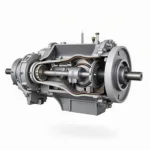Imagine driving your car on the highway. The engine is purring smoothly, but suddenly it starts to jerk, the check engine light flashes, and you feel your beloved vehicle losing power. The culprit? Possibly a small sensor with a significant impact: the differential pressure sensor, also known as the pressure difference sensor.
“Differential pressure sensor? Never heard of it!” you might be thinking. No problem, many car owners feel the same way. Yet, this inconspicuous sensor plays a crucial role in the performance and environmental compatibility of your vehicle. But what exactly does it do?
From Air Pressure Difference to Optimal Combustion: How the Differential Pressure Sensor Works
Simply put, the differential pressure sensor measures the difference between two pressures. Sounds simple, right? In a car, it measures the difference between the ambient air pressure and the pressure in the exhaust system.
What’s the point of that? It’s quite simple: Based on this pressure difference, the engine control unit can obtain vital information about the condition of the Exhaust Gas Recirculation (EGR) system and the Diesel Particulate Filter (DPF).
- EGR Example: A functioning EGR valve recirculates a portion of the exhaust gases back into the combustion chamber. This lowers the combustion temperature and reduces the formation of harmful nitrogen oxides. The differential pressure sensor helps the engine control unit determine the optimal amount of exhaust gas to recirculate.
- DPF Example: The diesel particulate filter filters soot particles from the exhaust stream. Over time, the filter becomes clogged and needs to be regenerated. The differential pressure sensor detects an increased exhaust back pressure and signals to the engine control unit that regeneration is necessary.
Defective Differential Pressure Sensor? Here’s How to Recognize It!
A faulty differential pressure sensor can lead to various problems, ranging from a slight loss of power to the engine going into limp mode. Typical signs of a defective sensor include:
- Check engine light illuminating
- Loss of power, especially in the lower RPM range
- Engine jerking
- Increased fuel consumption
- Problems during the emissions test
“Sounds like a lot of trouble!” you might be thinking now. True, but don’t panic! With the right know-how and a little DIY skill, you can even replace the differential pressure sensor yourself.
Replacing the Differential Pressure Sensor: Here’s How!
Before you reach for your toolbox, you should be sure that the differential pressure sensor is actually defective. A diagnosis in a specialist workshop can provide clarity.
Expert tip from Michael Schmidt, Master Mechanic at Auto Parts Pro: “A defective differential pressure sensor is often confused with other problems in the exhaust system. A professional diagnosis is therefore essential before you start working on it yourself.”
Differential Pressure Sensor: A Small Sensor with Great Significance
The differential pressure sensor may be an inconspicuous component, but it plays a vital role in the performance, environmental compatibility, and longevity of your car. Therefore, pay attention to the signs mentioned above and don’t hesitate to visit a specialist workshop if you experience problems.
Do you have questions about the differential pressure sensor or other topics related to cars? Feel free to leave us a comment or visit our website autorepairaid.com. Our experts will be happy to help!
Further Questions About the Differential Pressure Sensor:
- How much does a new differential pressure sensor cost?
- Can I clean the differential pressure sensor myself?
- What are the consequences of a permanently defective differential pressure sensor?
- Are there differences in differential pressure sensors for gasoline and diesel engines?
Would you like to learn more about how your car works or are you looking for helpful tips for repair and maintenance? Then check out our other articles on autorepairaid.com!

